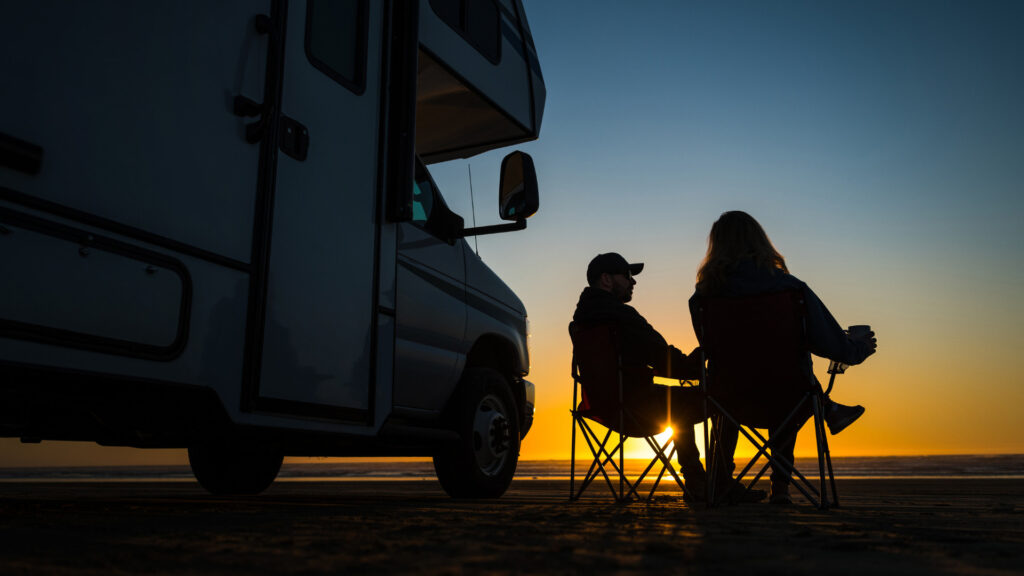



Some of our favorite childhood memories involved sand. Seriously, who didn’t love playing in the sandbox as a kid?
Does a trip to the beach even count if you didn’t build a sand castle? However, now that we’re adults, our affinity for sand isn’t quite the same.
We’ve developed a love for boondocking, especially out west. Unfortunately, if you’re not careful while boondocking, you and your RV could get stuck in the sand.
Today, we want to help you avoid and escape these situations.
Let’s get started!
Boondocking is a unique type of camping that typically takes place in RVs in remote, undeveloped areas. These campsites have no facilities or amenities, and the campers must come prepared to be self-sufficient for their stay.
The Bureau of Land Management (BLM) and the United States Forestry Service (USFS) typically manage these areas of undeveloped land. However, some lands owned by state and local governments also allow recreational camping.
Those embracing the camping style enjoy the increased space and privacy it provides. Many campers have grown tired of crowded campgrounds and expensive reservation fees.
Some areas require an inexpensive permit, but most sites allow campers to stay for several days for free.
Many of the best boondocking spots are out west, where there’s also an abundance of sand. If you’ve ever tried to walk across a sandy beach, you likely realize that weight and unpacked sand don’t go well together.
Unfortunately, many boondockers don’t spend the time to research an area or how to access it and may find themselves driving through sand.
A heavy load, like an RV, will quickly sink in loose soil. An inexperienced driver’s initial reaction will likely be to give it more gas. However, this typically results in the wheels spinning and digging deeper into the sand.
It only takes getting stuck or finding yourself in a tough situation once before you’ll learn your lesson. We regularly used our electric bikes to ride ahead and confirm the area was safe for us to drive. This helped us avoid several potentially sketchy situations, many of which involved sand.

We recently saw an online post from a fellow boondocker who got stuck. The couple found themselves in a potentially dangerous situation while boondocking near Yuma, Ariz.
The couple attempted to turn their motorhome around. Unfortunately, their rear tires got into some loose sand, preventing them from gaining traction. Before they knew it, they were stuck and desperately needed help.
However, they struggled to find a local recovery company willing to come to their rescue. Drivers weren’t willing to haul their equipment past where the pavement ends.
Thankfully, the user posted an update several hours later, letting everyone know they were out of the predicament. While they didn’t explain how they got out, you can bet they learned a lesson.
It is possible to drive an RV on sand without getting stuck, but it requires a combination of skill, equipment, and preparation. If not, you could be in the same situation as the Facebook users we mentioned.
The first thing you need to do is to gather the necessary traction aids to help if you get stuck. Special sand mats and boards can help prevent your RV from sinking in the sand when driving on it.
However, you don’t want to wait until you get stuck to have these or any other rescue equipment on hand. It’s better to be safe than sorry.
Additionally, you want to lower your tire pressure before pulling onto the sand. The reduced pressure in your tires will increase the traction the rubber tires can get.
When driving on sand, you typically want your tire pressure around 20 PSI. Just make sure you plan to air them back up when you hit the road.
Once driving on the sand, go slow and steady. You don’t want to cause any sudden movements or stops that could cause you to sink. It’s also wise to avoid sharp turns, which can cause your tires to dig into the ground.

Even the most experienced RVers and boondockers can get stuck in the sand. We have some tips for getting unstuck.
The worst thing you can do is to keep pressing on the gas. This will only dig your tires deeper into the sand and worsen things. In addition, you can cause serious damage to your vehicle.
You should immediately lay off the gas when your tires have lost traction. Put your vehicle in park and get out to evaluate the situation. You can save yourself a tremendous amount of frustration by doing this.
If done quickly, you can get yourself out of the situation. Unfortunately, many drivers try to free themselves by pushing the gas a few times. This typically ends with the driver needing assistance to escape.
Pro Tip: If you’ve never tried dry camping or boondocking, try these Tips For an Effortless Trip!
If your tires sink into the sand, you must start digging. Hopefully, you came prepared with a shovel. If not, you can use various tools to move the sand away from your tires. Depending on the weather, you may need to take turns and breaks frequently to avoid overheating.
The goal of your digging should be to create a path for the RV to move forward. Take your time while digging, and don’t try to rush it. If you do, you’ll likely exhaust yourself. Remember, slow and steady wins the race!
You’ll likely need to create traction between your tires and the sand to get unstuck. One of the best ways to quickly do this is to let some air out of your tires. You want to lower the PSI to approximately 20. This just might give you enough support to get out of the situation.
Additionally, this would be a great time to use any traction mats you brought. Place them snugly in front of the tire stuck in the sand. Slowly but firmly drive onto them. With luck, they’ll help you get out.
Unfortunately, there’s a chance you could find yourself in over your head. Attempting to bite off more than you can chew will likely only worsen things. You must know when to throw in the towel and call for help.
Your options will greatly depend on where you got stuck. As we discovered through the Facebook users we mentioned earlier, some companies might be unable to help. Or they don’t want to put themselves or their equipment in a risky situation.
If you have an emergency roadside service, they may come to your rescue. You can also contact local off-roading groups, which can be very helpful and have the necessary equipment and expertise to save the day.
Keep in Mind: Are you having trouble finding a campsite? You’re not alone!
No matter what happens, you must stay calm. However, we understand this is typically easier said than done. Regardless, it’s critical if you want to get out of the sticky situation.
Most people don’t make the best decisions when in a panic. Don’t be afraid to walk away for a minute or two if no one is in danger. This can help you clear your head and process the entire situation. You may even think of a solution or option you hadn’t considered.
Sand can sneak up on you when you least expect it. As a result, prepare for the worst-case scenario when boondocking. You don’t want to find yourself in a dangerous situation.
Some locations may not have reliable cell phone service, and you may end up praying someone comes to your rescue.
To enjoy many uneventful adventures, come prepared and self-sufficient, especially to avoid getting stuck in the sand.

